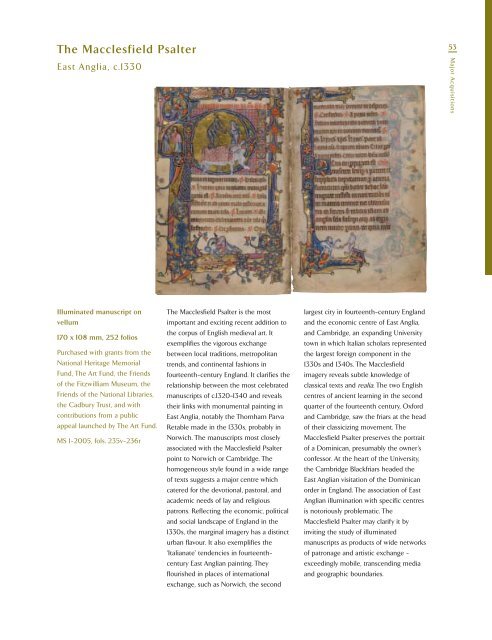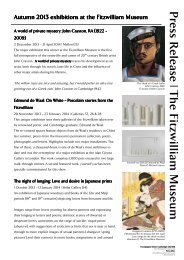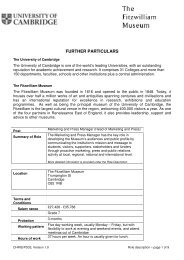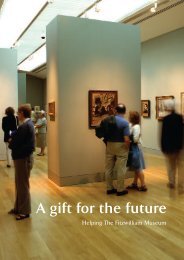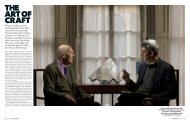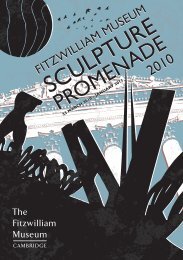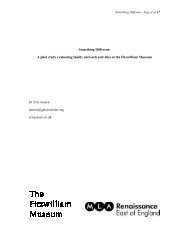The Fitzwilliam Museum - University of Cambridge
The Fitzwilliam Museum - University of Cambridge
The Fitzwilliam Museum - University of Cambridge
You also want an ePaper? Increase the reach of your titles
YUMPU automatically turns print PDFs into web optimized ePapers that Google loves.
<strong>The</strong> Macclesfield Psalter<br />
East Anglia, c.1330<br />
Illuminated manuscript on<br />
vellum<br />
170 x 108 mm, 252 folios<br />
Purchased with grants from the<br />
National Heritage Memorial<br />
Fund, <strong>The</strong> Art Fund, the Friends<br />
<strong>of</strong> the <strong>Fitzwilliam</strong> <strong>Museum</strong>, the<br />
Friends <strong>of</strong> the National Libraries,<br />
the Cadbury Trust, and with<br />
contributions from a public<br />
appeal launched by <strong>The</strong> Art Fund.<br />
MS 1-2005, fols. 235v-236r<br />
<strong>The</strong> Macclesfield Psalter is the most<br />
important and exciting recent addition to<br />
the corpus <strong>of</strong> English medieval art. It<br />
exemplifies the vigorous exchange<br />
between local traditions, metropolitan<br />
trends, and continental fashions in<br />
fourteenth-century England. It clarifies the<br />
relationship between the most celebrated<br />
manuscripts <strong>of</strong> c.1320–1340 and reveals<br />
their links with monumental painting in<br />
East Anglia, notably the Thornham Parva<br />
Retable made in the 1330s, probably in<br />
Norwich. <strong>The</strong> manuscripts most closely<br />
associated with the Macclesfield Psalter<br />
point to Norwich or <strong>Cambridge</strong>. <strong>The</strong><br />
homogeneous style found in a wide range<br />
<strong>of</strong> texts suggests a major centre which<br />
catered for the devotional, pastoral, and<br />
academic needs <strong>of</strong> lay and religious<br />
patrons. Reflecting the economic, political<br />
and social landscape <strong>of</strong> England in the<br />
1330s, the marginal imagery has a distinct<br />
urban flavour. It also exemplifies the<br />
‘Italianate’ tendencies in fourteenthcentury<br />
East Anglian painting. <strong>The</strong>y<br />
flourished in places <strong>of</strong> international<br />
exchange, such as Norwich, the second<br />
largest city in fourteenth-century England<br />
and the economic centre <strong>of</strong> East Anglia,<br />
and <strong>Cambridge</strong>, an expanding <strong>University</strong><br />
town in which Italian scholars represented<br />
the largest foreign component in the<br />
1330s and 1340s. <strong>The</strong> Macclesfield<br />
imagery reveals subtle knowledge <strong>of</strong><br />
classical texts and realia. <strong>The</strong> two English<br />
centres <strong>of</strong> ancient learning in the second<br />
quarter <strong>of</strong> the fourteenth century, Oxford<br />
and <strong>Cambridge</strong>, saw the friars at the head<br />
<strong>of</strong> their classicizing movement. <strong>The</strong><br />
Macclesfield Psalter preserves the portrait<br />
<strong>of</strong> a Dominican, presumably the owner’s<br />
confessor. At the heart <strong>of</strong> the <strong>University</strong>,<br />
the <strong>Cambridge</strong> Blackfriars headed the<br />
East Anglian visitation <strong>of</strong> the Dominican<br />
order in England. <strong>The</strong> association <strong>of</strong> East<br />
Anglian illumination with specific centres<br />
is notoriously problematic. <strong>The</strong><br />
Macclesfield Psalter may clarify it by<br />
inviting the study <strong>of</strong> illuminated<br />
manuscripts as products <strong>of</strong> wide networks<br />
<strong>of</strong> patronage and artistic exchange -<br />
exceedingly mobile, transcending media<br />
and geographic boundaries.<br />
53<br />
Major Acquisitions


